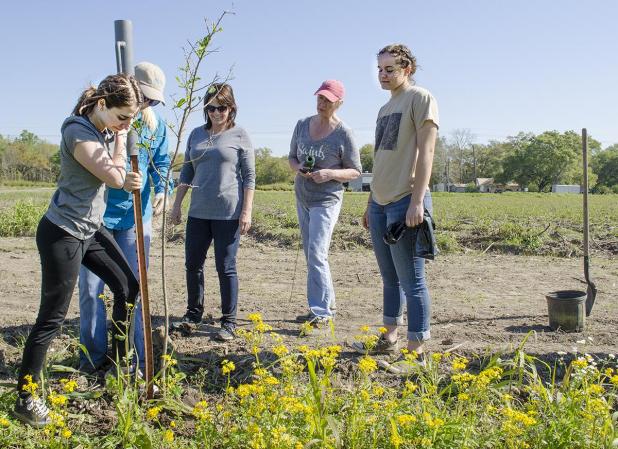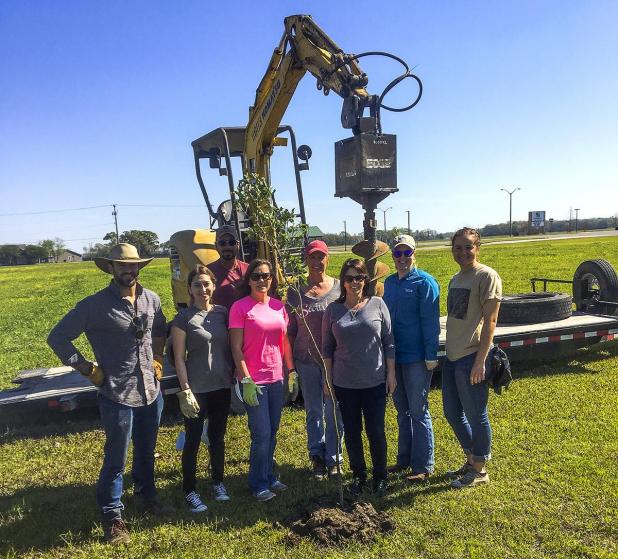
Jessica Randazzo, Asst. Extension Agent, LSU AgCenter, sets a tree-marker, Thursday, while Andrea Dumesnil, St. Mary Soil and Water Conservation District, Juanita Clements, USDA-Farm Services Agency and Kayla Hebert, USDA-Natural Resources Conservation Service look on.

From left are Micah Patout, Jessica Randazzo, Donald Legnon, Kimberly S. Walden, Andrea Dumesil, Juanita Clements, Kayla Hebert and Marley Darden pose in front of the auger that saved hours of work in this year’s planting. In years past, the holes for the saplings were dug with shovels, by hand.
The Trees on the Stretch
By CASEY COLLIER
If one was lucky enough to be traveling on La. 182 in the crisp, sunny wherewithal of Thursday morning, along the Adeline Stretch between Jeanerette and Charenton, the rhythmic lines of the sugar cane fields may have appeared disrupted by pickup trucks, an industrial auger and hunched figures with their hands full.
That was the roadside planting of live oak saplings by a fistful of happy volunteers, in the breezy morning shine.
They did it last year, this year, and they are working toward providing the same sight next year, doing the same work, just a little further down the road and at various other locales.
The St. Mary Water and Soil Conservation District, in concert with the United States Department of Agriculture’s Natural Resources Conservation Service and Farm Service Agency are working with LSU AgCenter, the local 4-H club and the Chitimacha Tribe of Louisiana in an endeavor to restore uniformity in number to the oaks along La. 182.
Andrea Dumesnil, SWCD, says the funding for the project comes from the Apache Corporation and their Tree Grant Program, which she intends to apply for again in June, with an eye to next spring’s prospective road-lining.
The oak-planting project started with Juanita Clements, USDA-FSA.
Of the projects impetus, Clements said, “I wanted to do it, but I didn’t know where to go, and there was someone working for the Soil and Water Conservation District who found a grant with Apache, and she got the grant, and then we worked together.”
Clements said that SWCD secures the grant/trees, “and we all participate in restoring the oaks to the way they used to be.”
Clements and Dumesnil remember when the St. Mary Parish stretch of La. 182 was galleried along its roadside by long, green reaches of oak trees, where now it is merely intermittently peppered with them.
What’s more is they have been working to plant live oaks at other points throughout the parish: Raintree Elementary School, Centerville Park and B. Edward Boudreaux Middle School, to name a few.
As part of the “New Deal” in the 1930s and 40s, President Franklin D. Roosevelt created a public work relief program called the Civilian Conservation Corps.
The live oaks were originally planted for that program.
Dumesnil said, “We have come across several elderly people who came out here as students, and planted trees.”
Clements added, “Ms. Martha Boudreaux, who is since deceased, who was at high school at Franklin High, she so wanted to come plant a tree, but they would only let the boys come (originally). So, she was 90-something years old when we first started the (new) program, and she came out here in a wheel chair to participate in planting that tree.”
The re-planting project has been going on for five years so far, and this year, the Chitimacha Tribe was represented, in part, by 4-H volunteer, Marley Darden, then later also by Kim Walden, Chitimacha’s Cultural Department Director and Tribal Historic Preservation Officer.
“Our volunteers up here are also representing the Chitimacha,” Dumesnil said. “They send people, if we need water, they’ll send their fire trucks out here. So we work with the tribe, as well.”
In advance, and to wit, Dumesnil said if there are extra trees next year, she hopes to work with Walden to plant trees on the reservation, along the Ralph Darden Memorial Parkway.
Of the grant’s allotment possibly expanding, Dumesnil said, “I asked for 200 trees this year, and they sent me 150. So, I’ll ask for 200 trees next year, and maybe they’ll send me 200.”
On account of the placement of the trees being required to clear 45-feet from the highway’s center-line, the planters find themselves at the edges of properties of cane farmers, with whom they have to work for permission and to establish the parameters of planting.
According to Dumesnil, it is the harvesting of the cane that has posed the greatest danger to the oak saplings in years past. With the harvesting machines moving toward a single and solitary purpose, the saplings have tended to pay the price by proximity.
This year, however, the planting crew is optimistic they have taken the necessary safeguards to allow the new trees their opportunity to flourish. The flagging of metal posts tied to the saplings, and drains placed near their bases have come into employ for the future oaks, to raise their visibility and to protect them from fast-moving mowers and harvesters.
Dumesnil said she hopes to see more done in the way of public maintenance of the young trees, but she also understands that planting them on private property makes that a tricky, if not moot proposition.
Darden said she likes the idea of driving down the planted highway, in days to come, exclaiming to her kids-to-be, that the trees through and under which they are passing, are the very same ones she helped to plant, years ago.
With any luck, history will repeat itself for such an exclamation.
